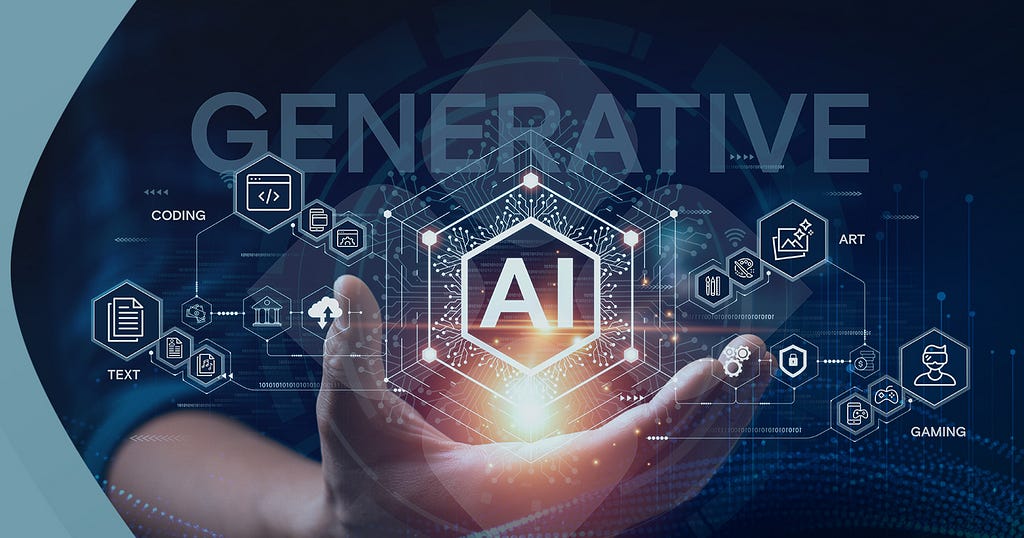Unlocking Future Trends and Innovations Shaping the Generative AI Landscape.
As we approach 2025, the generative AI value chain is poised for significant transformation, driven by rapid advancements in technology and evolving market demands. The integration of AI into various sectors is reshaping how businesses operate, create, and deliver value. From content generation and design to personalized marketing and customer interactions, generative AI is enabling organizations to streamline processes, enhance creativity, and improve decision-making. As this technology matures, we can expect a more robust ecosystem characterized by collaborative partnerships among tech developers, data providers, and end-users.
Emerging trends, such as the rise of AI ethics and regulatory frameworks, will also play a crucial role in shaping the value chain, ensuring responsible and sustainable AI practices. Furthermore, the development of advanced machine learning algorithms and the proliferation of cloud-based solutions will enhance the accessibility and scalability of generative AI tools. As these changes unfold, understanding the evolving dynamics of the generative AI value chain will be essential for businesses aiming to harness its potential and maintain a competitive edge in an increasingly AI-driven landscape.
Table of Content
Understanding Generative AI
What is Generative AI Value Chain?
Current State of the Generative AI Value Chain
Key Drivers of Change in the Generative AI Value Chain
Predictions for the Evolution of the Value Chain in 2025
Emerging Trends in the Generative AI Landscape
Implications for Stakeholders
Challenges to Consider
Conclusion
Understanding Generative AI
Generative AI refers to a class of artificial intelligence techniques designed to create new content or data that resembles existing material. Unlike traditional AI, which primarily focuses on analyzing data and making predictions, generative AI uses algorithms to generate text, images, music, and even videos. At the core of this technology are sophisticated models, such as generative adversarial networks (GANs) and transformers, which learn patterns and structures from large datasets.
These models can produce creative outputs that are often indistinguishable from human-generated content. The applications of generative AI span various fields, including art, entertainment, marketing, and software development, offering innovative solutions for content creation, personalized experiences, and problem-solving. As generative AI continues to advance, it raises important questions about ethics, copyright, and the implications of machine-generated content, necessitating a thoughtful approach to its integration into society and business practices.
What is Generative AI Value Chain?
The generative AI value chain encompasses the entire process of creating, developing, deploying, and utilizing generative AI technologies to deliver value across various industries. It begins with data collection, where diverse datasets are gathered to train AI models, ensuring they learn patterns and structures effectively. The next stage involves model development, utilizing techniques such as generative adversarial networks (GANs) or transformer models to create algorithms capable of producing high-quality content.
Following model training, the deployment phase integrates these algorithms into applications, allowing businesses to generate text, images, music, or other creative outputs. This stage often involves collaboration between AI developers, data providers, and end-users to ensure that the solutions meet specific industry needs. Once deployed, the AI models are continually refined through feedback loops, optimizing their performance based on user interactions and evolving market demands.
Finally, the value chain also considers ethical and regulatory frameworks that guide responsible AI usage, ensuring that innovations align with societal norms and standards. Overall, the generative AI value chain is a dynamic ecosystem driving creativity, efficiency, and innovation across various sectors.
Current State of the Generative AI Value Chain
The current state of the generative AI value chain is characterized by rapid advancements and widespread adoption across various industries. As organizations increasingly recognize the potential of generative AI, significant investments are being made in data collection, model development, and deployment strategies. Leading tech companies are leveraging large datasets to train sophisticated models, enabling the generation of high-quality text, images, and other creative content with remarkable accuracy and speed.
Startups are emerging to fill niche markets, offering specialized tools that cater to specific business needs, such as personalized marketing, content creation, and design. Furthermore, collaboration between AI developers and businesses is fostering innovation as companies seek to integrate generative AI into their operations to enhance efficiency and customer engagement.
However, challenges remain, including ethical considerations around bias, copyright issues, and the need for robust regulatory frameworks to guide responsible AI use. Overall, the generative AI value chain is evolving rapidly, driven by technological advancements and growing demand for creative and efficient solutions, while also necessitating a thoughtful approach to its implications on society and industry standards.
Key Drivers of Change in the Generative AI Value Chain
The generative AI value chain is undergoing a significant transformation driven by various key factors. Understanding these drivers of change is essential for businesses looking to harness the potential of generative AI technologies. Here are the main drivers influencing the generative AI value chain:
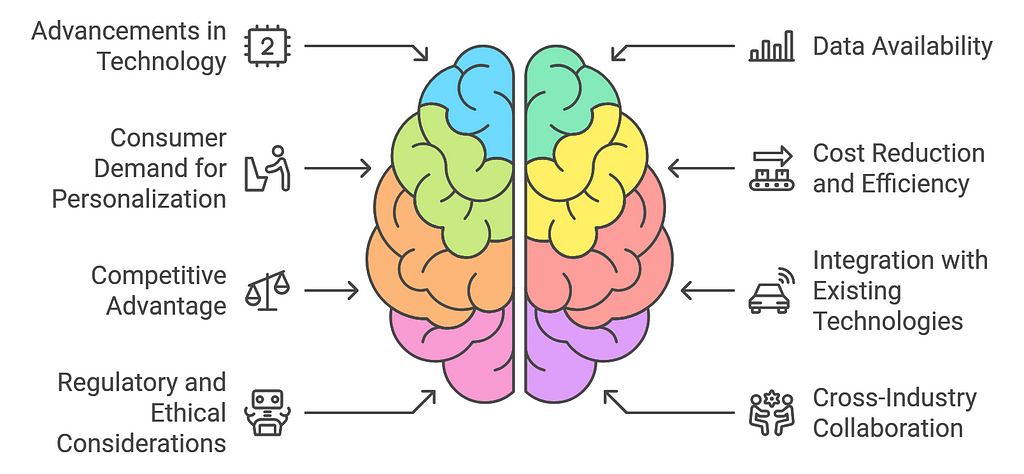
1. Advancements in Technology
- Improved Algorithms: Continuous improvements in machine learning algorithms, particularly deep learning and transformer models, are enhancing the capabilities of generative AI.
- Computational Power: The increasing availability of powerful hardware, including GPUs and TPUs, is enabling the training of more complex models and the processing of larger datasets.
2. Data Availability
- Big Data: The explosion of data generated from various sources (social media, IoT devices, customer interactions) provides the raw material needed for training generative AI models.
- Open Datasets: The rise of open datasets and collaborative data-sharing initiatives is facilitating easier access to diverse data sources for model training.
3. Consumer Demand for Personalization
- Tailored Experiences: As consumers increasingly expect personalized content and experiences, businesses are leveraging generative AI to create custom marketing materials, product recommendations, and user experiences.
- Content Creation: Generative AI enables rapid content generation, allowing businesses to meet consumer demands for fresh, relevant content across multiple channels.
4. Cost Reduction and Efficiency
- Automation of Creative Processes: Generative AI automates content creation, design, and other creative processes, reducing costs and time spent on manual tasks.
- Resource Optimization: Organizations can leverage generative AI to optimize resource allocation, improving operational efficiency across departments.
5. Competitive Advantage
- Innovation: Companies are increasingly adopting generative AI to innovate and differentiate their products and services in competitive markets.
- Agility: Generative AI allows businesses to respond more rapidly to market changes and customer needs, enhancing their ability to compete effectively.
6. Integration with Existing Technologies
- Seamless Integration: The ability to integrate generative AI with existing business processes and technologies (e.g., CRM systems and marketing platforms) enhances its applicability and effectiveness.
- API Accessibility: The availability of APIs and tools for easy integration allows businesses to adopt generative AI solutions without extensive infrastructure changes.
7. Regulatory and Ethical Considerations
- Compliance Requirements: Businesses must navigate evolving regulations regarding data privacy, AI usage, and intellectual property, driving the need for responsible, generative AI practices.
- Ethical AI Development: There is increasing pressure to develop ethical AI solutions that minimize bias and ensure fairness, which influences how generative AI models are created and deployed.
8. Cross-Industry Collaboration
- Partnerships: Collaborations between tech companies, academia, and industries foster innovation and accelerate the development of generative AI solutions.
- Knowledge Sharing: Industry consortia and research initiatives promote knowledge sharing and best practices, driving advancements in generative AI capabilities.
9. User-Friendly Interfaces
- Low-Code/No-Code Platforms: The emergence of low-code and no-code platforms makes generative AI accessible to non-technical users, broadening its adoption across various sectors.
- Enhanced UX: Improved user interfaces and tools for interacting with generative AI simplify the process of content creation and customization.
10. Global Market Dynamics
- Emerging Markets: The growth of digital economies in emerging markets is increasing the demand for generative AI solutions as businesses seek to leverage technology for growth and innovation.
- Cultural Adaptation: Generative AI can help companies create culturally relevant content and products tailored to specific regional markets, driving global business expansion.
These key drivers are reshaping the generative AI value chain, influencing how businesses develop and implement generative AI technologies. Companies that understand and adapt to these changes will be better positioned to leverage generative AI for competitive advantage and innovation in their respective markets.
Predictions for the Evolution of the Value Chain in 2025
The evolution of the value chain in 2025 is expected to be significantly influenced by advancements in technology, shifts in consumer behavior, and changes in the global business landscape. Here are some predictions for how the value chain will evolve over the next few years:
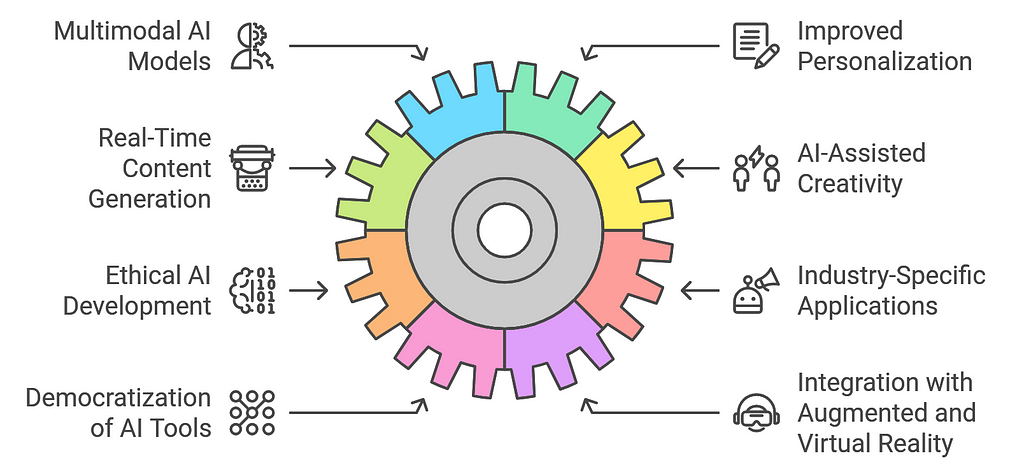
1. Increased Automation Across the Value Chain
- End-to-End Automation: Businesses will adopt more advanced automation solutions, integrating AI and machine learning across all stages of the value chain, from supply chain management to customer engagement.
- Robotic Process Automation (RPA): RPA will be increasingly used to handle repetitive tasks, allowing employees to focus on more strategic activities.
2. Greater Focus on Sustainability
- Sustainable Practices: Companies will prioritize sustainability in their value chains, adopting eco-friendly practices and sourcing materials responsibly to meet consumer expectations and regulatory requirements.
- Circular Economy Models: The shift towards circular economy models will influence how businesses design products, manage waste, and engage with suppliers and customers.
3. Enhanced Data Utilization
- Data-Driven Decision Making: The value chain will become more data-centric, with organizations leveraging advanced analytics to inform decision-making and optimize operations.
- Real-Time Insights: Businesses will increasingly use IoT and AI to gather real-time data, enabling agile responses to market changes and consumer demands.
4. Personalization at Scale
- Tailored Experiences: Companies will leverage generative AI and machine learning to deliver highly personalized products, services, and marketing strategies at scale.
- Consumer-Centric Design: The value chain will shift towards a more consumer-centric model, with organizations prioritizing user feedback and preferences in product development.
5. Collaboration and Ecosystem Building
- Strategic Partnerships: Businesses will increasingly collaborate with technology providers, suppliers, and even competitors to create ecosystems that enhance innovation and improve efficiency.
- Open Innovation: The rise of open innovation models will enable companies to share knowledge and resources, fostering collective problem-solving and creativity.
6. Integration of AI and Machine Learning
- AI-Driven Insights: The integration of AI and machine learning will enable businesses to gain deeper insights into customer behavior, market trends, and operational efficiency, transforming how decisions are made across the value chain.
- Predictive Analytics: Predictive analytics will become commonplace, helping companies forecast demand, optimize inventory, and enhance supply chain resilience.
7. Enhanced Customer Engagement Channels
- Omnichannel Strategies: Businesses will adopt omnichannel strategies that seamlessly integrate physical and digital interactions, providing consumers with a consistent experience across platforms.
- AI-Enabled Interactions: AI agents and chatbots will play a key role in customer engagement, providing instant support and personalized recommendations.
8. Decentralization of Operations
- Local Production Models: The value chain may shift towards more localized production models to reduce lead times, enhance responsiveness, and mitigate risks associated with global supply chains.
- Distributed Workforces: The rise of remote work will lead to more decentralized operational models, with teams collaborating across geographies and time zones.
9. Focus on Cybersecurity and Data Privacy
- Robust Security Measures: As reliance on digital technologies increases, businesses will prioritize cybersecurity across their value chains to protect sensitive data and maintain customer trust.
- Regulatory Compliance: Organizations will need to stay compliant with evolving data protection regulations, necessitating greater transparency and accountability in data handling.
10. Shift to Subscription and As-a-Service Models
- Recurring Revenue Streams: Many industries will move towards subscription and as-a-service models, enabling businesses to create consistent revenue streams and foster long-term customer relationships.
- Flexible Offerings: This shift will require companies to be more flexible in their offerings, allowing for customization and adaptation based on customer needs.
The evolution of the value chain in 2025 will be characterized by increased automation, a strong emphasis on sustainability, enhanced data utilization, and a focus on customer-centric strategies. Businesses that adapt to these trends will be better positioned to thrive in an increasingly competitive and dynamic marketplace.
Emerging Trends in the Generative AI Landscape
The generative AI landscape is rapidly evolving, with several emerging trends shaping its future. These trends are driven by advancements in technology, changing consumer expectations, and the increasing integration of AI into various sectors. Here are some of the key emerging trends in the generative AI landscape:
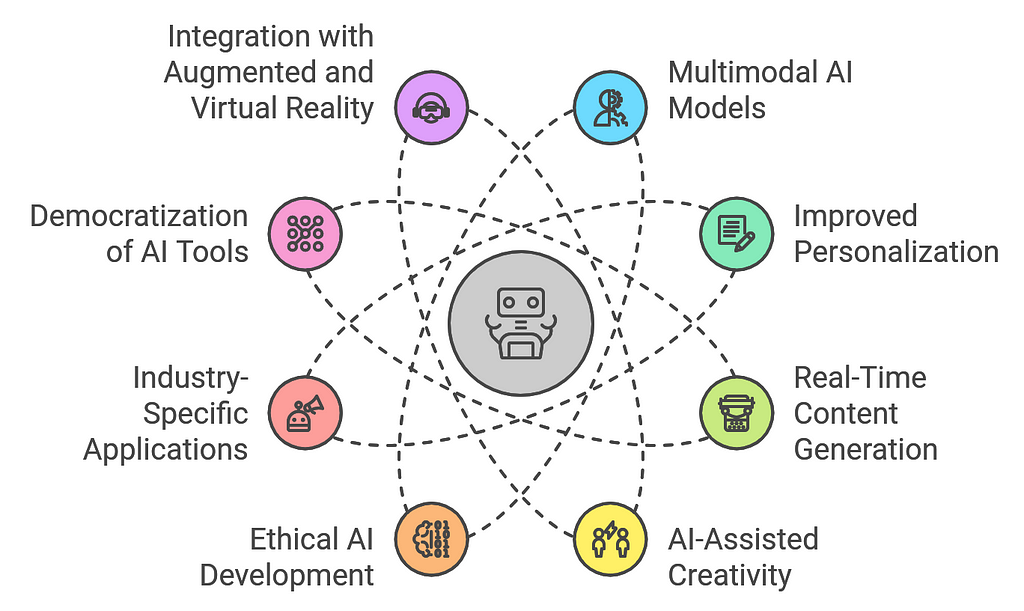
1. Multimodal AI Models
- Integration of Different Data Types: Future generative AI models will increasingly combine various types of data inputs, such as text, images, audio, and video, to create more comprehensive and contextually rich outputs.
- Enhanced Creativity: Multimodal capabilities will allow AI systems to generate content that reflects a deeper understanding of complex themes and concepts across different media.
2. Improved Personalization
- Hyper-Personalized Content: Generative AI will enable brands to create highly personalized content tailored to individual preferences, behaviors, and past interactions, leading to improved customer engagement.
- Dynamic Adaptation: AI systems will be able to adapt content in real-time based on user feedback and interactions, providing a more responsive and engaging experience.
3. Real-Time Content Generation
- On-Demand Creation: As AI technology continues to advance, generative AI will facilitate real-time content generation for applications such as social media, marketing campaigns, and customer interactions.
- Live Interaction: Businesses will leverage generative AI to provide instant responses and content creation during live events or customer inquiries, enhancing user engagement.
4. AI-Assisted Creativity
- Collaboration Tools: Generative AI will serve as a collaborative tool for creative professionals, assisting in brainstorming, content creation, and design processes by providing suggestions and generating ideas.
- Enhanced Creativity: AI will not replace human creativity but will augment it, allowing artists, writers, and designers to explore new avenues of creativity and expression.
5. Ethical AI Development
- Responsible AI Practices: As awareness of AI ethics grows, organizations will focus on developing generative AI systems that prioritize fairness, transparency, and accountability.
- Bias Mitigation: Efforts to identify and mitigate bias in AI models will be paramount, ensuring that generated content is equitable and representative.
6. Industry-Specific Applications
- Tailored Solutions: Generative AI will increasingly be customized for specific industries, such as healthcare (drug discovery, medical imaging), finance (report generation, risk assessment), and entertainment (game design, scriptwriting).
- Niche Expertise: Specialized generative AI applications will emerge, enabling organizations to leverage AI for unique challenges and opportunities within their sectors.
7. Democratization of AI Tools
- Accessibility for Non-Experts: The rise of user-friendly generative AI tools will empower non-experts to create and utilize AI-generated content, driving broader adoption across various industries and sectors.
- Low-Code/No-Code Platforms: The emergence of low-code and no-code platforms will facilitate the integration of generative AI into business processes, enabling users with minimal technical knowledge to harness its capabilities.
8. Integration with Augmented and Virtual Reality
- Immersive Experiences: Generative AI will play a crucial role in creating immersive experiences in AR and VR environments, generating content and scenarios that enhance user engagement and interaction.
- Virtual Environments: Businesses will utilize generative AI to populate virtual spaces with realistic characters, objects, and narratives, transforming gaming, training, and virtual events.
9. Cross-Platform Content Creation
- Seamless Integration Across Platforms: Generative AI will enable content to be created and adapted seamlessly across various platforms, such as social media, websites, and mobile applications, ensuring a consistent brand presence.
- Automated Distribution: AI will automate the distribution and optimization of content across channels, ensuring maximum reach and engagement.
10. Focus on Collaboration and Interoperability
- Interconnected Systems: Generative AI systems will increasingly work together, allowing for seamless data exchange and collaborative content creation across different AI platforms and applications.
- Partnerships and Ecosystems: Organizations will collaborate with AI providers, tech companies, and research institutions to create ecosystems that drive innovation and enhance generative AI capabilities.
These emerging trends in the generative AI landscape highlight the technology’s transformative potential across industries and its ability to enhance creativity, efficiency, and personalization. As businesses adapt to these trends, they will be better positioned to leverage generative AI for competitive advantage and innovation.
Implications for Stakeholders
The projected changes in the value chain by 2025 will have significant implications for various stakeholders, including businesses, consumers, suppliers, investors, and regulators. Here’s a breakdown of these implications:
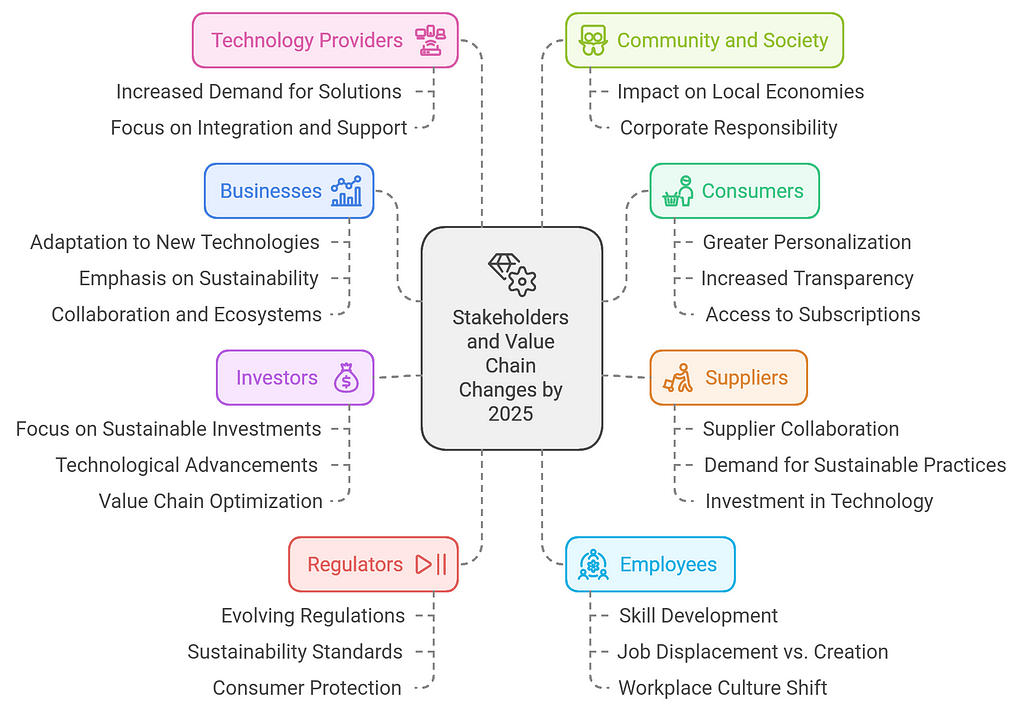
1. Businesses
- Adaptation to New Technologies: Companies will need to invest in advanced technologies (e.g., AI, IoT, automation) to stay competitive and meet changing market demands.
- Emphasis on Sustainability: Businesses will be under pressure to adopt sustainable practices, leading to potential shifts in sourcing, production, and waste management strategies.
- Collaboration and Ecosystems: Companies will increasingly collaborate with partners and competitors, leading to new business models and shared innovations.
2. Consumers
- Greater Personalization: Consumers can expect more personalized products and services, enhancing their overall experience and satisfaction.
- Increased Transparency: With enhanced supply chain tracking and reporting, consumers will gain better insights into product sourcing and sustainability practices, influencing their purchasing decisions.
- Access to Subscriptions: The shift toward subscription and as-a-service models will provide consumers with flexible access to products and services tailored to their needs.
3. Suppliers
- Supplier Collaboration: Suppliers will need to adapt to more collaborative relationships with businesses, focusing on innovation, responsiveness, and shared goals.
- Demand for Sustainable Practices: Suppliers may be required to adopt more sustainable practices and provide transparency regarding their own supply chains to meet the expectations of businesses and consumers.
- Investment in Technology: Suppliers will need to invest in technology and data-sharing capabilities to remain competitive and integrate into more automated value chains.
4. Investors
- Focus on Sustainable Investments: Investors will increasingly seek opportunities in companies that prioritize sustainability and responsible practices, shifting their focus towards ESG (Environmental, Social, and Governance) criteria.
- Technological Advancements: Investment opportunities will arise in companies that are early adopters of innovative technologies that enhance efficiency and competitiveness within the value chain.
- Value Chain Optimization: Investors may favor businesses that demonstrate effective value chain optimization through automation and data analytics, resulting in higher returns.
5. Regulators
- Evolving Regulations: Regulators will need to keep pace with technological advancements and the associated risks, developing new frameworks to ensure data privacy, security, and ethical AI usage.
- Sustainability Standards: There will be a growing emphasis on establishing regulations around sustainability practices and reporting, pushing businesses to comply with higher standards.
- Consumer Protection: Regulatory bodies will likely focus on ensuring consumer protection in areas like data usage, product safety, and fair practices, necessitating greater transparency from businesses.
6. Employees
- Skill Development: As automation and AI technologies reshape the workplace, employees will need to upskill and adapt to new roles that require digital literacy and technical competencies.
- Job Displacement vs. Creation: While some roles may be displaced due to automation, new job opportunities will emerge in tech-driven areas, requiring a balance between reskilling and hiring for evolving needs.
- Workplace Culture Shift: The integration of AI and automation may lead to changes in workplace dynamics, requiring businesses to foster a culture of collaboration between human workers and AI systems.
7. Technology Providers
- Increased Demand for Solutions: Technology providers will experience growing demand for innovative solutions that enable automation, data analytics, and enhanced customer experiences.
- Focus on Integration and Support: As businesses adopt new technologies, providers will need to focus on offering integration support and training to ensure successful implementation and adoption.
8. Community and Society
- Impact on Local Economies: As companies shift towards localized production and sustainable practices, local economies may benefit from job creation and increased community engagement.
- Corporate Responsibility: There will be heightened expectations for businesses to contribute positively to society, driving corporate social responsibility initiatives and community involvement.
The projected changes in the value chain by 2025 will create a dynamic environment that affects various stakeholders in multiple ways. Collaboration, innovation, and a focus on sustainability will be key themes as businesses adapt to these transformations, creating opportunities and challenges across the landscape. Stakeholders that embrace these changes will be better positioned to thrive in the evolving marketplace.
Challenges to Consider
As generative AI technologies continue to evolve and permeate various industries, several challenges warrant careful consideration. One of the most pressing issues is the potential for bias in AI-generated content, which can arise from the datasets used for training models. If these datasets contain biases, the outputs may perpetuate stereotypes or misinformation.
Additionally, the question of intellectual property rights becomes increasingly complex as AI-generated content blurs the lines of authorship and ownership. Ensuring compliance with ethical standards and regulatory frameworks is also critical, as organizations must navigate the legal landscape surrounding data privacy and the responsible use of AI.
Furthermore, there is a need for transparency in AI processes, enabling users to understand how outputs are generated and fostering trust in these technologies. Lastly, the rapid pace of innovation necessitates ongoing education and training for professionals to keep up with the evolving landscape, ensuring they can effectively leverage generative AI while mitigating potential risks.
Conclusion
In conclusion, the evolution of the generative AI value chain by 2025 will be marked by unprecedented growth and innovation, fundamentally reshaping industries and business operations. As organizations increasingly adopt AI technologies, the focus will shift toward creating more value through enhanced efficiency, creativity, and personalized customer experiences. Collaborative ecosystems involving tech developers, data providers, and industry stakeholders will emerge, fostering an environment ripe for innovation.
Additionally, the emphasis on ethical AI practices and compliance with regulatory frameworks will ensure that the deployment of generative AI is responsible and sustainable, addressing concerns around bias, data privacy, and accountability. Companies that embrace these changes and adapt to the evolving landscape will find new opportunities for growth and differentiation.
As we look ahead, staying informed about the trends and dynamics within the generative AI value chain will be critical for organizations seeking to leverage AI’s full potential. By strategically aligning their goals with the advancements in generative AI, businesses can navigate the complexities of this transformation and position themselves as leaders in an increasingly AI-driven world.
How Will the Generative AI Value Chain Evolve in 2025? was originally published in The Capital on Medium, where people are continuing the conversation by highlighting and responding to this story.
